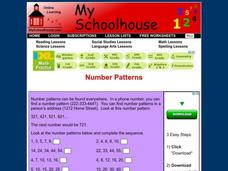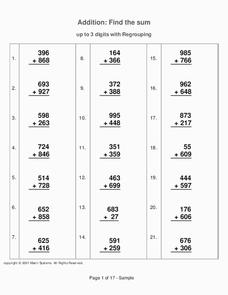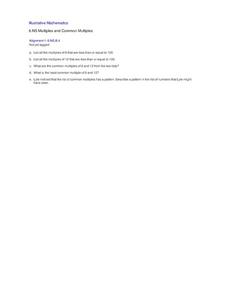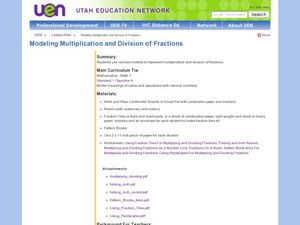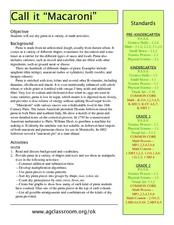Curated OER
Finding Addition Patterns
Students practice finding the sums of two-one digit numbers. For this addition lesson plan, students also record facts onto an addition chart.
Curated OER
King Street Patterns
In this number patterns worksheet, students examine the pattern on the worksheet and then respond to 2 questions that require them to fill in the missing numbers and explain how they came to those answers.
Curated OER
Hidden Patterns
In this number pattern activity, students use addition and subtraction to determine the next number in the pattern of numbers. There are 8 questions on this activity and the numbers are primarily 3 digits.
Curated OER
What's the Pattern?
In this pattern instructional activity, 3rd graders find the missing number to complete each of the six patterns. The missing numbers are provided and students determine which pattern they belong in.
Curated OER
Number Patterns
In this online interactive number patterns worksheet, students read examples and use their problem solving skills in order to solve to 22 problems that require them to complete number sequences.
Curated OER
Math: Basic Math Applications
In this math worksheet, students answer 303 problems including addition of numbers with decimal points, multiplication word problems, and rounding numbers to the nearest one thousand.
Curated OER
Searching For A Pattern
Students investigate the concept of number patterns. They practice recognizing various forms of them. Students solve different problems using multiples of different numbers. The multiples are then explained to be in a sequence.
Curated OER
Repeating Digits in Addition
In this patterns worksheet, students solve 4 short answer problems. Students find the pattern of adding the digits one through nine and extend that pattern to natural numbers with the same digit in every place.
Curated OER
How using number patterns help us add or subtract
Second graders use a number line to understand multiples. In this number line lesson, 2nd graders use a floor size number line and calculate problems with multiples. Students complete a worksheet with multiples.
Curated OER
On the Road Again
Students work with patterns to develop formulas that will help them determine total cost. In this patterning lesson, students watch a video about an NBA trainer. (not included) They work in groups to access the assigned Internet websites...
Curated OER
Problem Solving
Second graders practice problem solving strategies. In this problem solving instructional activity, 2nd graders use strategies such as guess and check, acting out, drawing pictures and looking for patterns to solve problems. Students...
Curated OER
It Just Keeps Going and Going...
Students explore patterns, identify patterns, and complete a variety of patterns. They view and discuss an online video and identify the different patterns from the film, then using a hundreds grid create an original pattern using their...
Curated OER
Counting by 3s, 4s, and 5s
Can learners recognize the pattern in these number sequences? Here's a hint: it's skip counting by either three, four, or five. There are three examples at the top demonstrating each of these, and scholars complete 15 number sequences to...
Curated OER
Sequences
Provide your class with a comprehensive set of examples that help define sequences. They view a wide variety of sequences that range from animals, to letters and sounds. They work through each sequence to determine what should come next....
Illustrative Mathematics
Multiples and Common Multiples
Learners are asked to find multiples and common multiples of two numbers. They must take their findings and find a pattern between the numbers and explain their reasoning. Use this resource with The Florist Shop activity in this series...
Curated OER
Modeling Multiplication and Division of Fractions
Create models to demonstrate multiplication and division of fractions. Using fraction tiles to model fractions, pupils explore fractions on a ruler and use pattern blocks to multiply and divide. They also create number lines with fractions.
Curated OER
Call it "Macaroni"
Who knew there were so many fun educational opportunities featuring pasta? Scholars read a brief informational text about the history of pasta (note that "macaroni" is spelled two different ways, so address this if kids are reading...
EngageNY
The Power of Algebra—Finding Primes
Banks are responsible for keeping our financial information safe. Mathematics is what allows them to do just that! Pupils learn the math behind the cryptography that banks rely on. Using polynomial identities, learners reproduce the...
Los Angeles County Office of Education
Assessment for the California Mathematics Standards Grade 1
Here is an assessment designed to test mathematicians' knowledge of writing numbers, comparing numbers, skip counting, solving addition and subtraction problems; along with measuring objects, telling time, identifying shapes, reading...
Concord Consortium
Last Digit Arithmetic
Mathematics involves a study of patterns. The exploratory lesson has learners consider the addition pattern in different sets of numbers. Each set has a different pattern that pupils describe mathematically. The patterns involve both...
Curated OER
Palindromes
In this math activity, students solve 56 multiplication problems. Students read about palindromes and discover patterns in multiplying by 11's and multiplying 8-digit numbers.
Curated OER
Odds and Evens
What happens when you multiply an odd number by an odd number? Scholars find out as they focus on patterns and number attributes while solving 48 multiplication problems. The first set has them multiply two odd numbers and record what...
Beacon Learning Center
Ten Pins
Multiplying with multiples of 10, 100, and 1,000 provides an opportunity to discuss patterns that arise with zeros. The class uses these patterns to solve problems. Then they rotate through three work stations, including a computer-based...
Curated OER
Counting Forward or Back
What comes next? Young counters follow the stone path to each house, filling in numbers in a sequence as they go. Some of these move forward and some backward, but all progress by ones. Learners start with given numbers and then follow...






